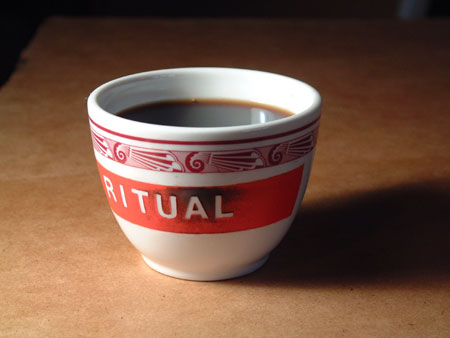|
Ceramics: Diner Cups

Diner Coffee Mug 1990
Using an ever-growing list of words, two words are chosen and applied to a mug. One word wraps the outside of the mug while the other follows the curve of the inside. By their placements, the two words cannot be viewed simulaneously (they only exist together in the mind). It then becomes the drive of the mind to connect these two words in a way that makes sense to the observer's consciousness. How this assemblage is achieved varies according to the individual and his or her life experiences.
In example, the word glazed to the outside of one such mug is "picnic". The word glazed inside is "suicide". These two words carry their own psychological weight with the viewer and the mind begins to rationalize or find a connection between the two disparate ideas and emotions until a satisfactory resolve is found.
The origin of this project began with the study of ceramics. Ceramic art is enhanced and plagued by its own history. Invariably one must choose how to deal with the dichotomy. As Chinese and Japanese influences are the dominating deep-rooted historical forces that drive much of functional ceramics, I looked to find an American counterpart to it. The Japanese tea ceremony seemed a natural point of departure. With the catalyst of the Boston Tea Party, America tried to do away with its ties to tea drinking, its history and its rituals, becoming a nation of coffee drinkers. Soon industry replaced the craftsman as the prime producer of most common ceramics. Coffee became the drink to wake us up in the morning and the drink to sip at an afternoon break. The rituals of old tea ceramonies are gone, replaced by moments we take out of our day to get our heads together over a cup of coffee. So with that I selected the restaurant coffee mug as the vessel to impart the work